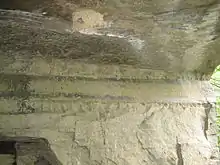Sitovo inscription
The Sitovo inscription is an inscription that has yet to be satisfactorily translated. It was discovered in 1928 by an archaeological expedition led by Alexander Peev on the wall of a rock shelter near the village of Sitovo, close to Plovdiv, Bulgaria. In 1943 Peev, an active anti-fascist, was executed by firing squad on suspicion of sending a coded message to the Soviet Union, after he sent an example of the text to Soviet archaeologists, in the hope that they could decipher its meaning.[1][2] The inscription was published in 1950 by Z. R. Morfova.


Characteristics
The inscription is in two lines which are 3.40 metres (11.2 ft) long. The written signs are 40 centimetres (16 in) tall.
Possible translations
Various attempts by both amateurs and professionals to translate it have been made. It has been variously identified as local ancient language, Celtic, Slavic, and Phrygian.[3]
See also
References
- "Alexander Peev (1886-1943) and the Ancient Sitovo Script". thesanghakommune.org. 26 February 2017.
- Moss, Candida (6 August 2017). "Inside the Deadly Pursuit of Unsolved Languages" – via www.thedailybeast.com.
- Mel Copeland. "Translation of the Phrygian language".
The second inscription is a rock-text near Sitovo village at 30 km south-east of Plovdiv in the Rhodopes Range. After their own autopsia Bayun-Orel 1991, 144-148, dated the inscription in III-I c. B.C. and saw on the rock "Ipta" as "figurine, cult object, image (in paredria?) with Bacchus' figurine."
[sic]